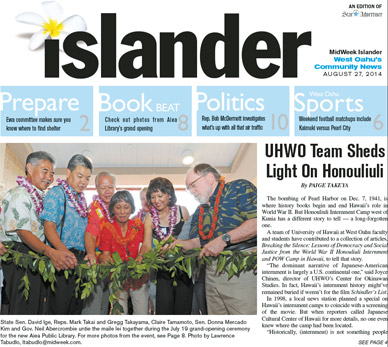UHWO Team Sheds Light On Honouliuli
The bombing of Pearl Harbor on Dec. 7, 1941, is where history books begin and end Hawaii’s role in World War II. But Honouliuli Internment Camp west of Kunia has a different story to tell — a long-forgotten one.
A team of University of Hawaii at West Oahu faculty and students have contributed to a collection of articles, Breaking the Silence: Lessons of Democracy and Social Justice from the World War II Honouliuli Internment and POW Camp in Hawaii, to tell that story.
“The dominant narrative of Japanese-American internment is largely a U.S. continental one,” said Joyce Chinen, director of UHWO’s Center for Okinawan Studies. In fact, Hawaii’s internment history might’ve remained buried if weren’t for the film Schindler’s List.
In 1998, a local news station planned a special on Hawaii’s internment camps to coincide with a screening of the movie. But when reporters called Japanese Cultural Center of Hawaii for more details, no one even knew where the camp had been located.
“Historically, (internment) is not something people wanted to remember,” said Linda Nishigaya, a UHWO sociology professor emeritus and co-editor of the collection with UHWO anthropology professor Suzanne Falgout.
“What happened in Hawaii at Honouliuli is very different from what happened on the U.S. mainland,” Falgout said.
Mainland Japanese Americans were publically rounded up and incarcerated en masse. But this wasn’t feasible in Hawaii, which was dependent on a large Japanese-American work-force. Instead, only high-profile individuals — including community leaders, teachers, journalists, priests and fishermen — were taken away. Martial law kept selection criteria hidden from public view.
“Because only a select few were picked up and detained, co-workers and neighbors often assumed — erroneously, it turns out — that the military did, in fact, have incriminatory evidence against the internees,” said UHWO archaeologists Jeff Burton and Mary Farrell.
This led to a climate of fear and shame, and survivors and their families became reluctant to share their experiences.
A team of researchers and JCCH volunteers managed to find remnants of Honouliuli in 2002, on property now owned by Monsanto Corporation. (After the war, the camp had been dismantled and the land was sold.) As the site is adjacent to UHWO, the university was invited to participate in the research in 2009 — a project embraced by nine professors in eight disciplines.
They’ve uncovered a lot of hidden stories. In addition to Japanese Americans, other internees at Honouliuli included those of Okinawan descent (lumped in as Japanese) and local Caucasians (classified as Germans and Italians). Internees were almost exclusively male, but there were also eight Shinto priestesses held at Honouliuli.
Susan Matoba Adler, an early-childhood education professor at UHWO, focused on the effects internment had on the Japanese-American nuclear family, both at Honouliuli and at Manzanar, where her family was held.
“The role of the mother changed tremendously,” Adler said, noting that in Hawaii, women were forced to become providers when their husbands were sent away.
Hawaii also served as a transitory hub for thousands of POWs, including Italians, Koreans, Filipinos and Okinawans, among others in the Pacific Theater. In some ways, POWs had more freedom than Japanese-American internees, who were allowed only limited visitors and could not leave the camp.
“The POWs were given work releases, and they were allowed to go out into the community and work on various projects,” Falgout said. Some POWs got along so well with the community that local groups would bring them gifts at Christmas.
These stories are gathered in 10 articles in the collection, a special issue of the journal, Social Process in Hawaii. While this is an academic publication, contributors think the subject has a mainstream audience.
“The Honouliuli story is almost 75 years old, but it’s also completely up-to-date: In the U.S., we are still trying to figure out how to balance national security with civil rights,” said Burton and Farrell.
It helps that Breaking the Silence also is the only in-depth source of information on internment in Hawaii.
“There is nothing out there that really looks at what happened in Hawaii. It was always just the assumption that we were under martial law,” Adler said.
“Honouliuli was only one of the internment and POW sites in these Islands … (This) became a reality because people let it happen; it was forgotten because people chose to forget it,” Chinen said.
With talk of Honouliuli becoming a protected national historic site and increased academic interest in the issue, Breaking the Silence‘s authors are hopeful that internment in Hawaii will be quiet no longer.
Breaking the Silence is available for purchase at UHWO and UH-Manoa bookstores, JCCH, WWII Valor in the Pacific National Monument and UH Press.






